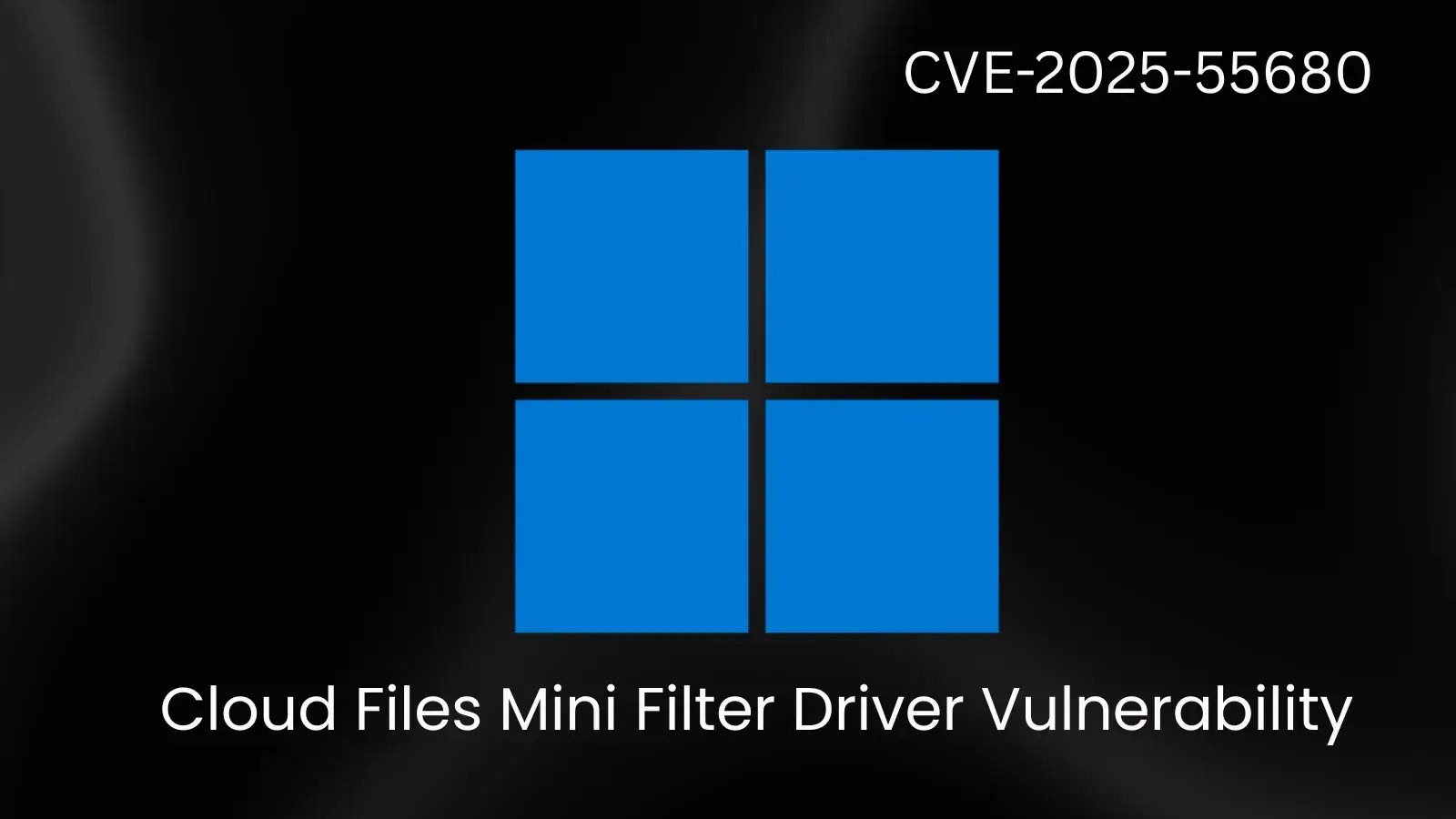
Windows Cloud Files Mini Filter Driver Vulnerability Exploited to Escalate Privileges
A new threat looms for Windows users, and it targets a seemingly innocuous component: the Cloud Files Mini Filter Driver. Recent discoveries reveal a critical privilege escalation vulnerability, CVE-2025-55680, that attackers are actively exploiting. This flaw allows malicious actors to bypass crucial file write protections and inject harmful code directly into system processes, posing a significant risk to data integrity and system security. Understanding this vulnerability and implementing timely countermeasures is paramount for any organization or individual relying on Windows systems.
Understanding the Windows Cloud Files Vulnerability: CVE-2025-55680
The vulnerability, identified as CVE-2025-55680, resides within the Windows Cloud Files Mini Filter Driver, specifically affecting the Cloud Files Filter (cldsync.sys). This driver is a core component responsible for managing the synchronization of cloud-backed files on Windows systems, enabling features like OneDrive’s Files On-Demand. The nature of the flaw permits a local attacker to escalate their privileges from a standard user to a system-level user. This severe escalation capability means an attacker, already present on a system with limited access, can gain complete control, bypassing established security boundaries and potentially corrupting or extracting sensitive data.
The core issue lies in how the driver handles certain operations, allowing for a bypass of write protections. This unintended consequence presents a critical attack vector for injecting malicious DLLs or altering system files, leading to persistent malware infections or complete system compromise. The severity of this vulnerability is high, demanding immediate attention from IT professionals and system administrators.
The Mechanics of Privilege Escalation
Privilege escalation is a nefarious technique where an attacker gains elevated access to resources that are normally protected. In the context of CVE-2025-55680, the Cloud Files Mini Filter Driver acts as the weak link. The typical attack scenario involves:
- Initial Access: An attacker first gains a foothold on the system, perhaps through a phishing attack or by exploiting another, less severe vulnerability.
- Exploiting the Driver: With local access, the attacker leverages the vulnerability in
cldsync.sys. This allows them to manipulate file operations in a way that circumvents intended write restrictions. - Code Injection: By bypassing these protections, the attacker can then inject their own malicious code, often in the form of a Dynamic Link Library (DLL), into critical system processes.
- Elevated Privileges: Once injected, the malicious code executes with the elevated privileges of the compromised system process, granting the attacker full control over the machine. This can lead to data exfiltration, installation of rootkits, or further network lateral movement.
The ability to inject code into system processes makes this vulnerability particularly dangerous, as it can hide malicious activity deep within the operating system, making detection and removal significantly more challenging. This also points to a broader concern about the security posture of core drivers within operating systems.
Remediation Actions
Addressing CVE-2025-55680 requires prompt and decisive action. Organizations and individual users must prioritize these steps to mitigate the risk:
- Apply Security Updates Immediately: Microsoft will undoubtedly release a patch to address this vulnerability. Ensure that all Windows systems are updated to the latest available security patches as soon as they are released. Configure automatic updates where possible to minimize exposure time.
- Implement Principle of Least Privilege: Restrict user accounts to the minimum necessary permissions. Even if an attacker gains initial access, having limited privileges will reduce the scope of damage they can inflict.
- Regularly Monitor System Logs: Pay close attention to logs for unusual activity, especially related to driver loading, process creation, and file system modifications. Anomalies could indicate an attempted or successful exploitation.
- Use Endpoint Detection and Response (EDR) Solutions: EDR tools can help detect and respond to suspicious activities that might indicate a privilege escalation attempt, even before a patch is available.
- Maintain Up-to-Date Antivirus/Anti-Malware Software: While not a direct patch for the vulnerability, robust security software can help detect and block the malicious payloads attackers might try to inject after exploiting the flaw.
- Disable Cloud Files if Not Necessary: If the Cloud Files feature (e.g., OneDrive Files On-Demand) is not critical for your operations, consider disabling it until patches are thoroughly vetted and applied.
Recommended Security Tools and Solutions
To effectively detect, scan for, and mitigate risks associated with vulnerabilities like CVE-2025-55680, a combination of tools is essential. Here’s a table outlining relevant solutions:
| Tool Name | Purpose | Link |
|---|---|---|
| Microsoft Defender for Endpoint | Advanced EDR, next-gen antivirus, and vulnerability management for Windows environments. | https://www.microsoft.com/en-us/security/business/microsoft-defender-for-endpoint |
| Tenable Nessus | Vulnerability scanner to identify missing patches and configurations that could expose systems. | https://www.tenable.com/products/nessus |
| Qualys VMDR | Cloud-based vulnerability management, detection, and response platform. | https://www.qualys.com/vmdr/ |
| Sysinternals Process Monitor | Advanced monitoring utility to track file system, Registry, and process/thread activity in real time. Useful for forensic analysis. | https://learn.microsoft.com/en-us/sysinternals/downloads/procmon |
| Open-source SIEM (e.g., ELK Stack) | For centralized log aggregation, analysis, and alerting across multiple systems, aiding in detection of anomalous behavior. | https://www.elastic.co/elastic-stack |
Conclusion
The discovery and exploitation of CVE-2025-55680 in the Windows Cloud Files Mini Filter Driver underscore the persistent threat of privilege escalation vulnerabilities. This flaw’s ability to bypass file write protections and inject malicious code into system processes presents a significant security challenge. Proactive application of security updates, vigilant system monitoring, and the strategic deployment of security tools are not merely best practices but critical necessities. Windows users and system administrators must prioritize these measures immediately to safeguard their digital infrastructure against this potent threat and maintain a resilient security posture.





